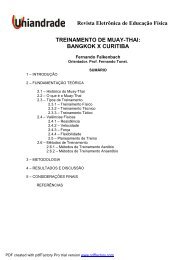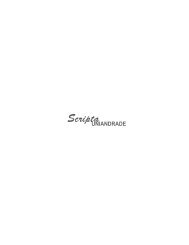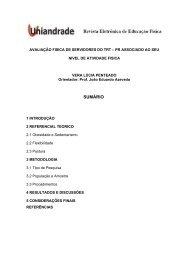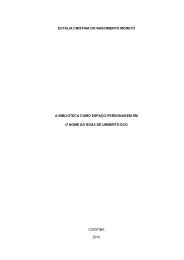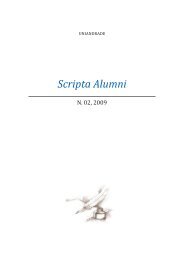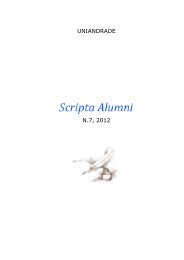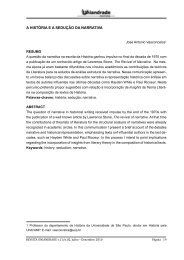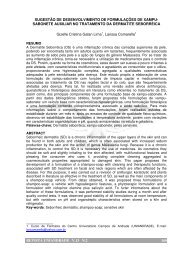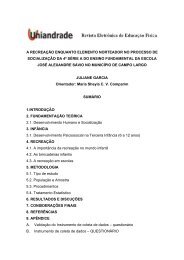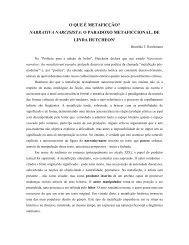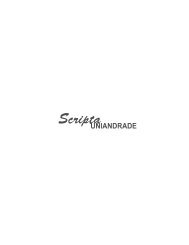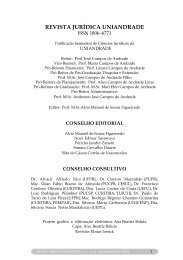- Page 1 and 2: Scripta Uniandrade, v. 9, n. 2, jul
- Page 3 and 4: Scripta Uniandrade / Brunilda T. Re
- Page 5 and 6: Textos intermidiáticos na literatu
- Page 7 and 8: perpétua por suspeita de terem pra
- Page 9 and 10: textos sob enfoque, de publicação
- Page 11 and 12: In the mid-nineties, 1995/96, an ar
- Page 13 and 14: task attracts the painter’s atten
- Page 15 and 16: evoquer la lune and Seeing Dutch, L
- Page 17 and 18: The second ekphrastic description,
- Page 19 and 20: Fig. 3 - Johannes Vermeer, The Musi
- Page 21: The excerpt starts from van Ruijven
- Page 25 and 26: other Frans at his new job (CHEVALI
- Page 27 and 28: ______. On Representation in Concre
- Page 29 and 30: A CONSTRUÇÃO DE UM ESPAÇO MÍTIC
- Page 31 and 32: medievais e clássicas, na Europa,
- Page 33 and 34: Pedro Paulo Garcia Ferreira Cathari
- Page 35 and 36: uma bifurcação, do lado esquerdo,
- Page 37 and 38: Como consequência, essa utopia, as
- Page 39 and 40: programático”, nos moldes de Má
- Page 41 and 42: JUNQUEIRA, Ivan. Simbolismo: origen
- Page 43 and 44: III III Goddess of Discord Choosing
- Page 45 and 46: EM NOME DO PAI: O TEXTO DE GERRY CO
- Page 47 and 48: 83% de todas as minisséries são a
- Page 49 and 50: ambas as mídias envolvidas, a comp
- Page 51 and 52: carismáticas, valores culturais e
- Page 53 and 54: parceria com Terry George. Tanto Sh
- Page 55 and 56: como sugere o nome do livro, em sua
- Page 57 and 58: prisão; anulação da sentença im
- Page 59 and 60: Na sequência, aparece a advogada G
- Page 61 and 62: Fig. 3 - Gerry Conlon em um telhado
- Page 63 and 64: As Figs. 6, 7 e 8 fixam o momento d
- Page 65 and 66: percebe que o filho está usando dr
- Page 67 and 68: destaque foi dado à foto de uma cr
- Page 69 and 70: Na narrativa fílmica, contudo, nã
- Page 71 and 72: 5 Versão em inglês: “I’ve spe
- Page 73 and 74:
STAM, R. Introduction: The Theory a
- Page 75 and 76:
Introdução Wit (1993) é a primei
- Page 77 and 78:
mecanismos da mente, em sua peça W
- Page 79 and 80:
Fig. 1 - 00:00:35 Fig. 2 - 00:00:40
- Page 81 and 82:
Estou indo muito rápido? Ótimo. A
- Page 83 and 84:
Essa fala é o primeiro marcador qu
- Page 85 and 86:
Este é um momento muito importante
- Page 87 and 88:
que a descoberta se deu no anivers
- Page 89 and 90:
Foi no atual momento de rememoraç
- Page 91 and 92:
Da mesma forma que o pai havia lhe
- Page 93 and 94:
Fig. 14 - 00:56:53:00 Fig. 13 - 00:
- Page 95 and 96:
2 [wit] s. Juízo m.; razão, habil
- Page 97 and 98:
Abstract: In Prospero’s Books (19
- Page 99 and 100:
Whitehall Palace and, probably beca
- Page 101 and 102:
etreat where he can shut out the ex
- Page 103 and 104:
are impregnated with the minerals,
- Page 105 and 106:
Frame 3 - Prospero and Ariel as a c
- Page 107 and 108:
subjects. The film’s title appear
- Page 109 and 110:
In Greenaway’s characterization o
- Page 111 and 112:
7 Our translation from Portuguese:
- Page 113 and 114:
STAM, Robert. Introdução à teori
- Page 115 and 116:
ROMEO AND JULIET: A TRAGEDY RETOLD
- Page 117 and 118:
In one of the takes that follows, s
- Page 119 and 120:
‘Yea’, quoth he, ‘dost thou f
- Page 121 and 122:
with the original’s aura of sacra
- Page 123 and 124:
Now old desire doth in his death-be
- Page 125 and 126:
that his brother is alive in the co
- Page 127 and 128:
SHAKESPEARE EM PORTUGUÊS DO BRASIL
- Page 129 and 130:
scholarly mas nem por isso erudita
- Page 131 and 132:
frequentemente fecham as cenas, em
- Page 133 and 134:
Todo esse cuidado e dedicação à
- Page 135 and 136:
— quase 70% do total — de fato
- Page 137 and 138:
Nº do Escansão Comentários verso
- Page 139 and 140:
O primeiro verso da fala é complet
- Page 141 and 142:
Antônio e Cleópatra; observe-se,
- Page 143 and 144:
AS CONVENÇÕES DO GÊNERO DETETIVE
- Page 145 and 146:
Publicada como volume à parte em 1
- Page 147 and 148:
descobrimos que o telefone que apar
- Page 149 and 150:
afirmação legítima? Aos meus olh
- Page 151 and 152:
Por fim, depois de falhar como dete
- Page 153 and 154:
Work que, em certas ocasiões, pare
- Page 155 and 156:
utilizamos uma abordagem que buscou
- Page 157 and 158:
REFERÊNCIAS AUSTER, P. City of Gla
- Page 159 and 160:
Introdução O presente estudo visa
- Page 161 and 162:
dois ou mais sistemas de signos e/o
- Page 163 and 164:
REPRODUÇÃO / HARPER COLLINS Fig.
- Page 165 and 166:
dentro das paredes - berrou o maior
- Page 167 and 168:
REPRODUÇÃO / HARPER COLLINS Fig.
- Page 169 and 170:
O poema é sobre a menina Bonnie qu
- Page 171 and 172:
REPRODUÇÃO / HARPER COLLINS Fig.
- Page 173 and 174:
GAIMAN, Neil ; MCKEAN, Dave. The wo
- Page 175 and 176:
Introdução Aceitas na contemporan
- Page 177 and 178:
linguagem dos quadrinhos ainda esta
- Page 179 and 180:
Como o quadro de Magritte, analisad
- Page 181 and 182:
texto de Carroll é transposto e il
- Page 183 and 184:
REPRODUÇÃO / JONATHAN CAPE Fig. 2
- Page 185 and 186:
Na obra de Bryan Talbot, o personag
- Page 187 and 188:
Além das referências aos quadrinh
- Page 189 and 190:
REFERÊNCIAS BARTHES, Roland. Mitol
- Page 191 and 192:
Resumo: O presente trabalho se prop
- Page 193 and 194:
cuja realização plena só se dá
- Page 195 and 196:
Vilém Flusser (2008, p.15), um dos
- Page 197 and 198:
cultural, uma vez que não somente
- Page 199 and 200:
mobilidade. No plano interativo, o
- Page 201 and 202:
Porém, o texto está muito além d
- Page 203 and 204:
Imagens, sons, gestos, cores, expre
- Page 205 and 206:
No Japão, segundo lugar no ranking
- Page 207 and 208:
www.youtube.com/watch?v=x8Imk7B7s1c
- Page 209 and 210:
Resumo: Este artigo demonstra as in
- Page 211 and 212:
Quando o computador e a internet co
- Page 213 and 214:
[…] a grande revolução propicia
- Page 215 and 216:
Penúltimo quadro do texto Autópsi
- Page 217 and 218:
Bomba, de Augusto de Campos. Imagem
- Page 219 and 220:
Totalmente composto em preto e bran
- Page 221 and 222:
Ilustração da página inicial do
- Page 223 and 224:
Life, de Décio Pignatari, disponí
- Page 225 and 226:
Ninguém, de Arnaldo Antunes. Image
- Page 227 and 228:
também pode fazer um retrato de Ma
- Page 229 and 230:
GUIMARÃES, D. A. D. Comunicação
- Page 231 and 232:
NORMAS DA REVISTA 1 Os trabalhos en



